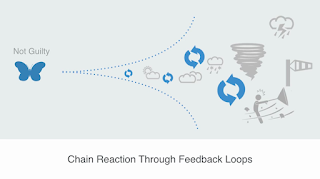Chaos & the Butterfly Effect
Chaos & the
Butterfly Effect.
When one observes the
entropic, disorderly world around us, we often call it chaotic, coming from the
word chaos, which from Greek, actually means ‘emptiness or nothingness of the universe, from which the Gods emerged.’ When we use entropy, meaning disorder’ we arrive automatically at the expression to
describe our world as being in chaos which we all can watch in the daily news.
Author James Gleick, who wrote a mind altering book named ‘Chaos, the third scientific revolution’, described Chaos Theory as a way to understand
that our world is not as predictable nor as controllable as mechanistic, empirical,
so called linear sciences, determine. In fact, it is the opposite of linearity
which is non-linearity which I wanted to mention in this column. Our
businesses, industries or organisations are often created as linear systems
based on linear cause and effect expectations only. They are built along
mathematical and modelling or Newtonian laws of physics. When something happens,
we actually believe that when we just write more regulations, our system can be
controllable again. But this is a false idea. We do have to realise that
non-linearity could be causing unexpected and non-controllable effects. Now, to
understand this, we’d have to understand that
so-called dynamic living systems, such as our organisations, can always be
affected by tiny fluctuations which can lead to enormous consequences. Have you
heard of the Butterfly Effect? When a butterfly flaps its wings in China, a
thunderstorm in America can be the result. When Edward Lorenz, a mathematician
by learning and a meteorologist by passion tried to use deterministic computer
modelling to predict the weather in a linear fashion, he was surprised that the
outcomes of his research looked very different then what his computer had
attempted to compute. Predictions according to universal laws of physics gave
very different results, namely that tiny errors in calculations led to enormous
errors. The experiment proved that any cause, direct or indirect, would
interfere with reality. The assumption that small influences could be ignored
ended. Systems Theory confirmed that everything is related with everything
else.
Now, apply this
insight to your organisation or company. When you see a truck driver park in
the wrong manner to load a cargo, or you watch an operator doing the wrong
thing, or understand that you did not sleep too much or that the food in the
cafeteria is inedible or that the heating coils of shore tank number 3 are not
working properly, but that you are pumping it out anyway because a customer
demands it…. You will now have to think about the
Butterfly Effect and accept that it is real and that ignoring it could lead to
entropy and chaos. You may now ask: ‘But how can we control it then?’ Well, you can’t. But what you can do is to use ‘Cybernetics’, with which you can build maximum resilience
and variety into your system. Stephen Hawkins was trying all his life to create
a ‘Theory of Everything’. He understood why.



Reacties
Een reactie posten